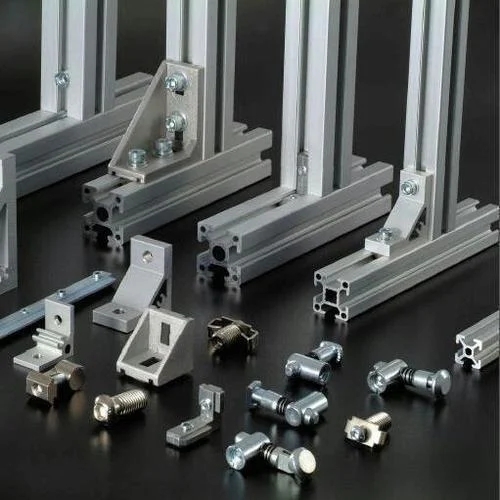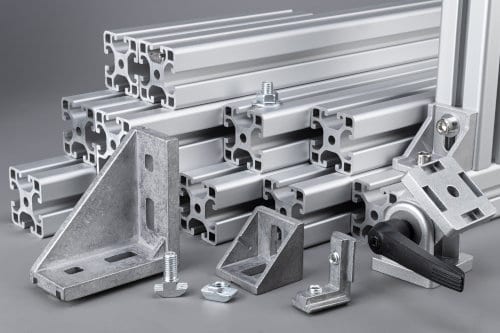English


Views: 222 Author: Tomorrow Publish Time: 2025-07-10 Origin: Site











Content Menu
● Understanding Aluminum Profile Extrusion
● Key Advantages of Aluminum Profile Extrusion
>> 2. Design Versatility and Precision
>> 4. Excellent Thermal and Electrical Conductivity
>> 5. Sustainability and Recyclability
>> 7. High Surface Quality and Finish Options
>> 8. Large and Complex Profiles
>> 9. Enhanced Mechanical Properties
>> 10. Ease of Fabrication and Assembly
● Applications of Aluminum Profile Extrusion
● FAQ
>> 1. What is aluminum profile extrusion?
>> 2. Why is aluminum extrusion preferred over other metals?
>> 3. Can aluminum extrusions be used in outdoor environments?
>> 4. How does aluminum extrusion contribute to sustainability?
>> 5. What industries commonly use aluminum profile extrusions?
Aluminum profile extrusion is a versatile manufacturing process that has revolutionized how aluminum is shaped and utilized across various industries. This technique involves forcing heated aluminum billets through a shaped die to create continuous profiles with specific cross-sectional designs. The resulting aluminum extrusions offer a unique combination of properties and benefits that make them indispensable in modern manufacturing, construction, transportation, electronics, and many other sectors.

Aluminum profile extrusion begins with heating a solid aluminum billet to make it malleable. The softened billet is then pushed through a steel die with a hydraulic press or ram. The die has an opening shaped to the desired profile, and as the aluminum is forced through, it takes on this shape in a continuous length. After extrusion, the profiles are cooled, cut to length, stretched to straighten, and often heat-treated to enhance mechanical properties. This process allows for the creation of complex shapes with precise dimensions and tight tolerances.
The extrusion process can be performed using different methods such as direct extrusion, indirect extrusion, and impact extrusion, each suited to specific production requirements and profile complexities. Additionally, the choice of aluminum alloy plays a crucial role in determining the mechanical properties and suitability of the extruded profiles for various applications.
One of the most significant advantages of aluminum profile extrusion is the exceptional strength-to-weight ratio. Aluminum is about one-third the weight of steel, iron, or copper, making extruded aluminum profiles much lighter while maintaining high strength. This characteristic is crucial in industries such as automotive, aerospace, and transportation, where reducing weight improves fuel efficiency and performance without compromising structural integrity.
The ability to reduce weight without sacrificing strength also contributes to lower transportation costs and easier handling during assembly and installation. This advantage is particularly important in sectors aiming for sustainability and energy efficiency.
Aluminum extrusion enables the production of complex and intricate profiles that would be difficult or impossible to achieve with other manufacturing methods. The process allows for varying wall thicknesses, internal reinforcements, and hollow or semi-hollow shapes within a single profile. This flexibility gives engineers and designers the freedom to create custom solutions tailored to specific functional and aesthetic requirements with tight dimensional tolerances.
Moreover, the extrusion process supports the integration of multiple functions into a single profile, such as channels for wiring, mounting points, or cooling fins, reducing the need for additional components and simplifying assembly.
Aluminum naturally forms a thin, protective oxide layer that shields it from corrosion. This inherent corrosion resistance makes extruded aluminum profiles ideal for outdoor, marine, and harsh environmental applications. Unlike steel, aluminum does not rust, which extends the lifespan of products and reduces maintenance costs.
Additionally, aluminum extrusions can be further treated with anodizing or powder coating to enhance corrosion resistance and surface durability, making them suitable for even more demanding environments.
Aluminum extrusions are widely used in applications requiring efficient heat dissipation or electrical conduction. Their thermal conductivity makes them perfect for heat sinks, cooling components, and electronics housings. Similarly, aluminum's electrical conductivity is valuable in electrical busbars, wiring, and power distribution systems.
The ability to extrude profiles with integrated cooling fins or channels enhances heat transfer efficiency, which is critical in high-performance electronics and LED lighting systems.
Aluminum is 100% recyclable without any loss of its inherent properties, making aluminum profile extrusion a sustainable manufacturing choice. Recycling aluminum requires only a fraction of the energy used to produce primary aluminum, reducing environmental impact. This sustainability factor aligns with global efforts to promote green manufacturing and circular economy principles.
The recyclability of aluminum also supports industries in meeting environmental regulations and corporate social responsibility goals, adding value beyond just material performance.
The extrusion process is highly efficient, producing near-net shapes that minimize material waste and reduce the need for secondary machining. Tooling costs for extrusion dies are generally lower than for casting or injection molding, and lead times are shorter. These factors contribute to lower overall production costs, especially for high-volume runs.
Furthermore, the ability to produce long continuous lengths reduces the number of joints and welds needed, which can lower labor costs and improve structural integrity.
Extruded aluminum profiles come with excellent surface quality that can be further enhanced with anodizing, powder coating, painting, or other finishing techniques. These finishes not only improve aesthetics but also add extra layers of protection against wear and corrosion.
The smooth surface finish of extruded profiles also facilitates easier cleaning and maintenance, which is important in applications such as food processing, medical equipment, and architectural elements.
Modern extrusion presses can produce large and wide aluminum profiles with thin walls, enabling lightweight yet strong components for big applications such as offshore helidecks, railway wall sections, boat masts, and large machine parts. This capability simplifies design and assembly while maintaining high performance.
The ability to produce large profiles also reduces the number of parts needed in an assembly, which can improve reliability and reduce manufacturing complexity.
The extrusion process produces a homogeneous structure free from cavities, chips, or pores, resulting in increased strength and wear resistance. Additionally, aluminum becomes stronger at lower temperatures, making extruded profiles suitable for cold-weather applications.
Heat treatment after extrusion can further enhance mechanical properties, allowing manufacturers to tailor the strength, hardness, and ductility of profiles to specific requirements.
Extruded aluminum profiles are easy to cut, machine, join, and assemble. Their precise dimensions and consistent quality simplify manufacturing processes and reduce assembly time, which is a significant advantage in mass production environments.
Joining methods such as welding, riveting, bolting, or adhesive bonding are all compatible with aluminum extrusions, offering flexibility in design and construction.

The advantages of aluminum profile extrusion have led to its widespread use across many industries:
- Construction and Architecture: Window frames, curtain walls, structural components, and decorative elements benefit from the material's strength, corrosion resistance, and aesthetic finish options.
- Transportation: Automotive parts, aircraft components, railcar sections, and marine equipment leverage aluminum's lightweight and strength to improve efficiency and safety.
- Electronics: Heat sinks, housings, and electrical busbars utilize aluminum's excellent thermal and electrical conductivity.
- Renewable Energy: Solar panel frames and mounting systems rely on aluminum extrusions for durability and corrosion resistance.
- Consumer Goods: Furniture, appliances, and sports equipment use aluminum extrusions for their design flexibility and lightweight properties.
- Industrial Machinery: Machine frames, conveyor systems, and tooling components benefit from aluminum's strength and ease of fabrication.
Aluminum profile extrusion offers a unique blend of lightweight strength, design flexibility, corrosion resistance, thermal and electrical conductivity, sustainability, and cost-effectiveness. These advantages make it a preferred manufacturing process for a vast range of applications, from small precision parts to large structural components. As industries continue to demand innovative, efficient, and environmentally friendly solutions, aluminum profile extrusion stands out as a cornerstone technology that meets these evolving needs with unmatched versatility and performance.

Aluminum profile extrusion is a manufacturing process where heated aluminum billets are forced through a shaped die to create continuous profiles with specific cross-sectional shapes. This process allows for complex and precise designs.
Aluminum extrusion is preferred because aluminum is lightweight, strong, corrosion-resistant, recyclable, and has excellent thermal and electrical conductivity. The extrusion process also allows for complex shapes and cost-effective production.
Yes, aluminum extrusions are highly corrosion-resistant due to the natural oxide layer that forms on their surface, making them ideal for outdoor and marine applications.
Aluminum is 100% recyclable without loss of properties, and recycling aluminum requires much less energy than producing new aluminum. This makes aluminum extrusion a sustainable manufacturing process that supports environmental goals.
Common industries include construction, automotive, aerospace, electronics, renewable energy, consumer goods, and industrial machinery due to the material's versatility and performance advantages.
Stainless Steel Grades 201 Vs 304: Cost Vs Performance Breakdown
316L Vs 316 Stainless Steel Grades: Which Is Better for Corrosion Resistance?
Comparing Austenitic Vs Martensitic Stainless Steel Grades: What You Need To Know?
Stainless Steel 430 Vs 304: Key Differences Explained for Manufacturers
304 Vs 316 Stainless Steel Grades: Which One Suits Your Project Best?
Stainless Steel Pipes Vs Galvanized Pipes: Durability And Cost Analysis
Comparing Stainless Steel Pipes And PVC Pipes: What You Need To Know?
Stainless Steel Pipes Vs Copper Pipes: Pros And Cons for Industrial Use
Seamless Stainless Steel Pipes Vs Welded Pipes: Key Differences Explained
Stainless Steel Pipes Vs Carbon Steel Pipes: Which One Suits Your Project?
